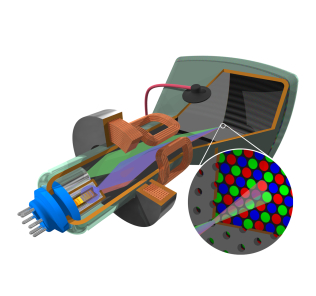CRT Displays
CRT, or Cathode Ray Tube, HDTVs use technology descended from both SDTV and computer monitors. Three electron guns are used to project, or paint, scanlines in varying combinations of Red, Green, and Blue. Although there are front projection CRT displays, this guide will focus on rear projection and direct view display CRTs.
Advantages
Unlike other newer types of HDTV, CRT is very mature technology. It's been used for decades in televisions and computer monitors. Since CRT isn't fixed pixel technology it does a very good job of displaying video in varying resolutions because, like a CRT computer monitor, the resolution of the display itself can be changed. CRT displays can also reproduce blacker blacks than other types of HDTV display. CRT displays are cheaper to produce than any other HDTV type, making them less expensive than other HDTVs of the same screen size for the same or higher quality. The tubes used in CRT projectors generally last much longer than the lamps in other projectors.
Disadvantages
 CRT's maturity comes with problems inherent in technology first developed more than a century ago. Its primary weaknesses are the three electron guns, which must all point to a single spot in order to accurately reproduce a color. This is primarily an issue with CRT RPTVs, which require the most (and most expensive) maintenance of any standard HDTV type. Periodic maintenance, including setting the convergence (making sure all three colors converge) must be performed. Additionally, when a single electron gun (red, green, or blue) needs replaced the other two should always be replaced at the same time to make sure the colors and brightness match, and of course convergence must be set at that time. CRT HDTVs are also much bulkier and heavier than other displays. Despite their excellence in reproducing various resolutions, no CRT HDTV can output 1080p.
CRT's maturity comes with problems inherent in technology first developed more than a century ago. Its primary weaknesses are the three electron guns, which must all point to a single spot in order to accurately reproduce a color. This is primarily an issue with CRT RPTVs, which require the most (and most expensive) maintenance of any standard HDTV type. Periodic maintenance, including setting the convergence (making sure all three colors converge) must be performed. Additionally, when a single electron gun (red, green, or blue) needs replaced the other two should always be replaced at the same time to make sure the colors and brightness match, and of course convergence must be set at that time. CRT HDTVs are also much bulkier and heavier than other displays. Despite their excellence in reproducing various resolutions, no CRT HDTV can output 1080p.
Direct View CRT
A direct view CRT is what most people think of when they think of SDTV. It's called direct view because the electron guns fire forward to display directly at the front of the TV. Direct View CRT HDTVs are difficult to find in sizes over 30". Another issue for these HDTVs is aspect ratio. Although some have a standard 16:9 AR, others use SDTV's 4:3 instead. This means true HDTV content has to be either distorted vertically or be letterboxed, similar to the way widescreen DVDs are displayed on an SDTV.
Rear Projection CRT
The earliest hi-def RPTVs used CRT technology. Although these units weigh hundreds of pounds and take up more space than any other HDTVs with comparable screen size. Their unbeaten color reproduction has made them difficult to replace for many HDTV early adopters.
Written by: Rich Fiscus

